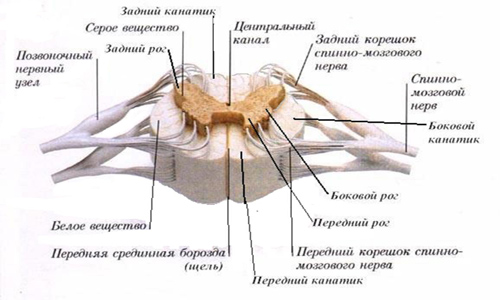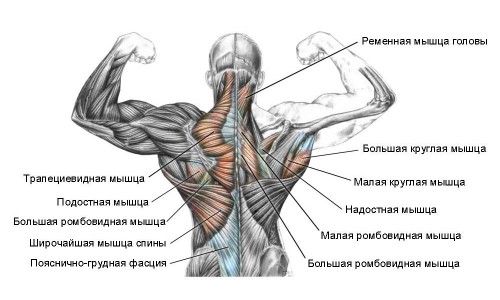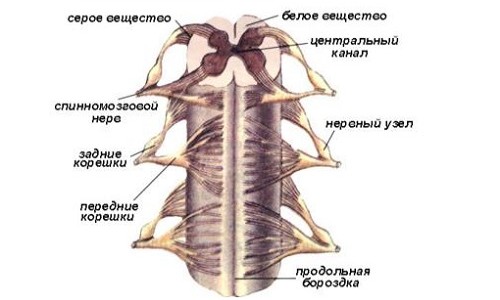The structure, anatomy and function of the cervical spine in humans
Cervical spine is the part of the spinal column from the skull base to the attachment of ribs. The division consists of 7 vertebrae which are designated by Latin letter and digits.

Numbering starts from the base of the skull. Special names have vertebrae C1 and C2, they are called Atlas and axis (Apistia).
How is the cervical spine?
The concept of "spine" usually include not only the bones of the vertebrae, and soft tissues:
- spinal cord
- nerve roots and ending;
- vessels that supply nourishment to the brain.
the Vertebral column consists of individual vertebrae, which are bonded by means of intervertebral disks.

Each vertebra is a hollow structure of bone tissue having an aperture through which passes the whole spinal cord. The upper part of the vertebrae is very strong and serves to protect the spinal cord from damage. Over tube between the spinal vertebrae are elastic cartilaginous disks.
When the man tilts his head, spine is shifted in the direction of it is due to the intervertebral discs.
The Muscles and ligaments hold the bone structure in a stable position. The cervical spine is the most mobile, so it most often violations occur. The most fragile and vulnerable part of this design from the point of view of anatomy is the intervertebral disc. The disc consists of:
- pulpous nucleus;
- the fibrous sheath.

The Core is shaped like a ball compressed, it is retained by a fibrous sheath. If this membrane is torn or stretched, it forms a hernia. Each element in the structure of the spine affects the health of the other components. Therefore, when the intervertebral discs are deformed, suffering and nerve endings, and blood vessels. In the cervical spine are blood vessels that carry oxygen and nutrients to the brain, so if the hernia or curvature of the spine compresses them, the person immediately experiences an adverse change in his health. The innervation of the spine are arranged in such a way that pain from the cervical spine may be given in the skull, shoulders and neck muscles. Because of the anatomy of the cervical spine in this area appear most often disease of the spine:
- degenerative disc disease
- spondylosis
- herniated disks.

The Second most frequent diseases – lumbar, which is located behind the breast. The picture with all segments of the human spine allows us to consider a characteristic S-shaped bend. A disadvantage of the structure of the spine is a strong pressure on the cervical and lumbar, which leads to natural physiological lordosis (bending).
arise As a pathology of the vertebral column?
In the high-risk group for diseases of the spine are the people leading a sedentary lifestyle. Many hours of computer work, long driving and lack of exercise lead to the following consequences:
- the muscles of the neck and shoulders weaken;
- is no more efficient system, which stabilizes the position of the spine;
- in the cervical spine occur atrophic changes of one group of muscles and strain of others;
- under the action of the muscles of the spine begins to curl, move about its normal axis;
- this affects the intervertebral discs, develops low back pain;
- when the fibrous ring can no longer hold the nucleus of the disc, it moves under the pressure of the weight of the person;
- if the hernia compresses the vessels and nerves, is developing a number of painful and unpleasant symptoms in the circulatory and nervous system.

The Spinal cord inside the spinal canal, is responsible for vital reflexes. Thanks to the work of the spinal cord is coordination between all the internal organs. The most adverse scenario of a hernia is the protrusion of nucleus pulposus contents into the lumen of the spinal canal. In this case, people can get paralysis, intense pain and many comorbidities. In addition to a sedentary lifestyle, the deformation of the intervertebral discs is called:
- obesity
- injuries of the cervical spine;
- disorders of metabolism due to which the cartilage loses its elasticity;
- malnutrition, low levels of vitamins D, E, calcium and magnesium in the diet
- chronic dehydration
- intense physical exertion, spinal cord injuries
- flat feet and other diseases of bones and joints.

The Skeleton isa single structure, each part of which affects the status of the other. Therefore, in the feet, arthrosis, arthritis and strains of any joint or bone of the skeleton to compensate for the system load adjustment. To support the weight of the body and provide the person the ability to move, the skeleton curves, it loses its symmetry and the natural anatomic shape.
The Treatment of flat feet, lordosis, scoliosis and other diseases of the musculoskeletal system is also necessary in order to prevent pathological changes in the remaining bone and cartilaginous structures of the skeleton.
The Latest stage adaptation of the skeleton under sub-optimal distribution of the load, is the formation of osteophytes. Osteophytes is thickening, growths on the surface of the bone. They are formed due to friction of bones against each other. For example, in the cervical osteophytes occur when the herniated disc. The vertebrae do not have any effective amortization of motion due to degenerative changes of the disc and begin to RUB and push at each other. The structure of the vertebrae is changed, the surface ceases to be smooth, when driving there is a crunch.
Peculiarities of innervation of the
The Segments of the spinal cord located in the cervical spine have a clear specialization. For that the spinal cord is responsible of each vertebra?
- In the area of the C1 vertebra are nerves that regulate the pituitary and inner ear. When the pinched nerve roots in this Department develop insomnia, severe headache, dizziness, loss of orientation in space. When the injury first vertebra occur fainting. From the nerve endings of this division depends on stable operation of the psyche, therefore, when degenerative disc disease C1-C3 person suffers from nervousness, diseases of the endocrine system and depression.
- contains the C2 Vertebral segment of the spinal cord, which is responsible for vision and hearing. Violations in the area of C1-C2 leading to reduction of vision and hearing, loss of sensation in the face and head. A sharp pinched nerve endings in the region of C1-C3 causes blackouts, fainting, a spike in blood pressure.
- Spinal cord vertebra C3 is associated with facial nerve that controls the facial expressions. When degenerative disc disease C3-C4 pain in the region of the upper jaw, especially in the teeth.
- contains the C4 Vertebral segment of the spinal cord associated with the head organs: nose and nasal sinuses, oral cavity and Eustachian tube. As a result of a pinched C4 nerve endings there is a hearing loss, facial neuralgia and changing facial expressions.
- Spinal cord C5-C6 coordinates the work of the vocal cords, muscles of the neck and forearms. Osteochondrosis in this Department the pain in the shoulder, in the back of the head. Possible loss of voice or change tone of speech.
- spinal cord Segment C7 is closely associated with the thyroid gland. When the pinched nerve roots normal production of thyroid hormones is disturbed, developed hypothyroidism and other endocrine diseases.
The Cervical spine has such a structure that any part of it inevitably affects the whole organism. It is therefore very important prevention of diseases of the spine.
How to keep a healthy back?
To maintain the natural shape of spinal column, needs a good muscular system. Equal development of all muscle groups helps:
- to avoid deformation of the intervertebral disc;
- to reduce the likelihood of injury of the spine;
- to protect yourself from a lot of disorders in the internal organs, which leads to a curvature of the spine.
To prevent enough to do any moving sport or at least to do exercises for the spine in the morning.
Additional sources:
A. N. Kucherov. “The cervical spine”.













